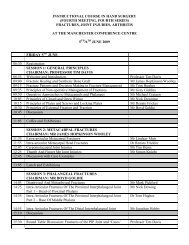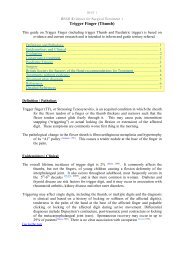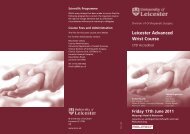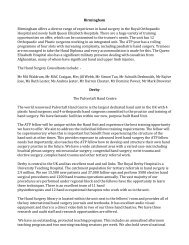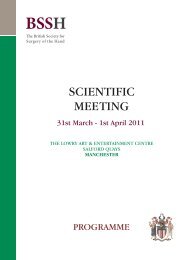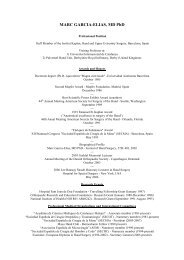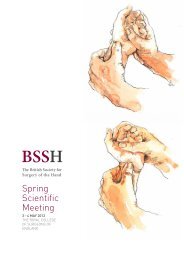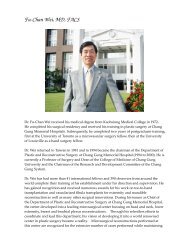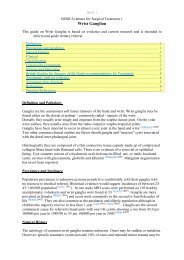here - The British Society for Surgery of the Hand
here - The British Society for Surgery of the Hand
here - The British Society for Surgery of the Hand
Create successful ePaper yourself
Turn your PDF publications into a flip-book with our unique Google optimized e-Paper software.
10:15 Discussion<br />
THURSDAY, 1 MAY<br />
Conclusion and Clinical Relevance: Our results demonstrate no significant difference in graft-take<br />
comparing grafts secured with a tie-over dressing or by quilting. Importantly, t<strong>here</strong> were no cases <strong>of</strong><br />
injury to <strong>the</strong> tendons or neurovascular structures in those cases w<strong>here</strong> <strong>the</strong> graft was secured by quilting.<br />
Our technique <strong>for</strong> securing <strong>the</strong> graft by quilting is less time consuming compared with a tie-over dressing.<br />
T<strong>here</strong><strong>for</strong>e, we no longer use tie-over dressings to secure full thickness grafts in <strong>the</strong> hand.<br />
10:22 Visual and Computer S<strong>of</strong>tware-Aided Estimates <strong>of</strong> Dupuytren’s Contractures, Correlation with<br />
Clinical Goniometric Measurements<br />
Dr R Smith, Pr<strong>of</strong>essor J J Dias, Mr A Ullah, Mr B Bhowal (Leicester)<br />
Aim: To assess <strong>the</strong> accuracy <strong>of</strong> visual and computer s<strong>of</strong>tware-aided estimations <strong>of</strong> Dupuytren’s contractures<br />
compared to clinical goniometric measurements.<br />
Introduction: Correction <strong>of</strong> Dupuytren’s contractures represents a significant workload. <strong>The</strong> success <strong>of</strong><br />
surgical release <strong>of</strong> an affected finger is measured by straightness, recurrence does occur. Patients requiring<br />
post-discharge follow-up should be kept to a minimum.<br />
Methods: Patients with Dupuytren’s disease had <strong>the</strong>ir hands digitally photographed by a consultant hand<br />
surgeon. <strong>The</strong>se digital images were visually assessed, noting <strong>the</strong>ir degree <strong>of</strong> contracture, by six orthopaedic<br />
staff. <strong>The</strong> same six people again assessed <strong>the</strong> images but aided with computer s<strong>of</strong>tware. Pearson’s<br />
correlations with <strong>the</strong> actual measurements were made and reliability was assessed with <strong>the</strong> intra-class<br />
correlation coefficient and test-retest analysis.<br />
Results: Sixty patients with Dupuytren’s disease had <strong>the</strong>ir hand photographed, 10 photographs were<br />
duplicated <strong>for</strong> test-retest analysis. This resulted in seventy-six unique Dupuytren affected finger joints:<br />
53 little PIPJ’s, 6 little DIPJ’s and 17 ring PIPJ’s. <strong>The</strong> average correlation across all assessors between <strong>the</strong><br />
actual measurements and <strong>the</strong> visual estimations was 0.83 (0.81-0.86) (p



